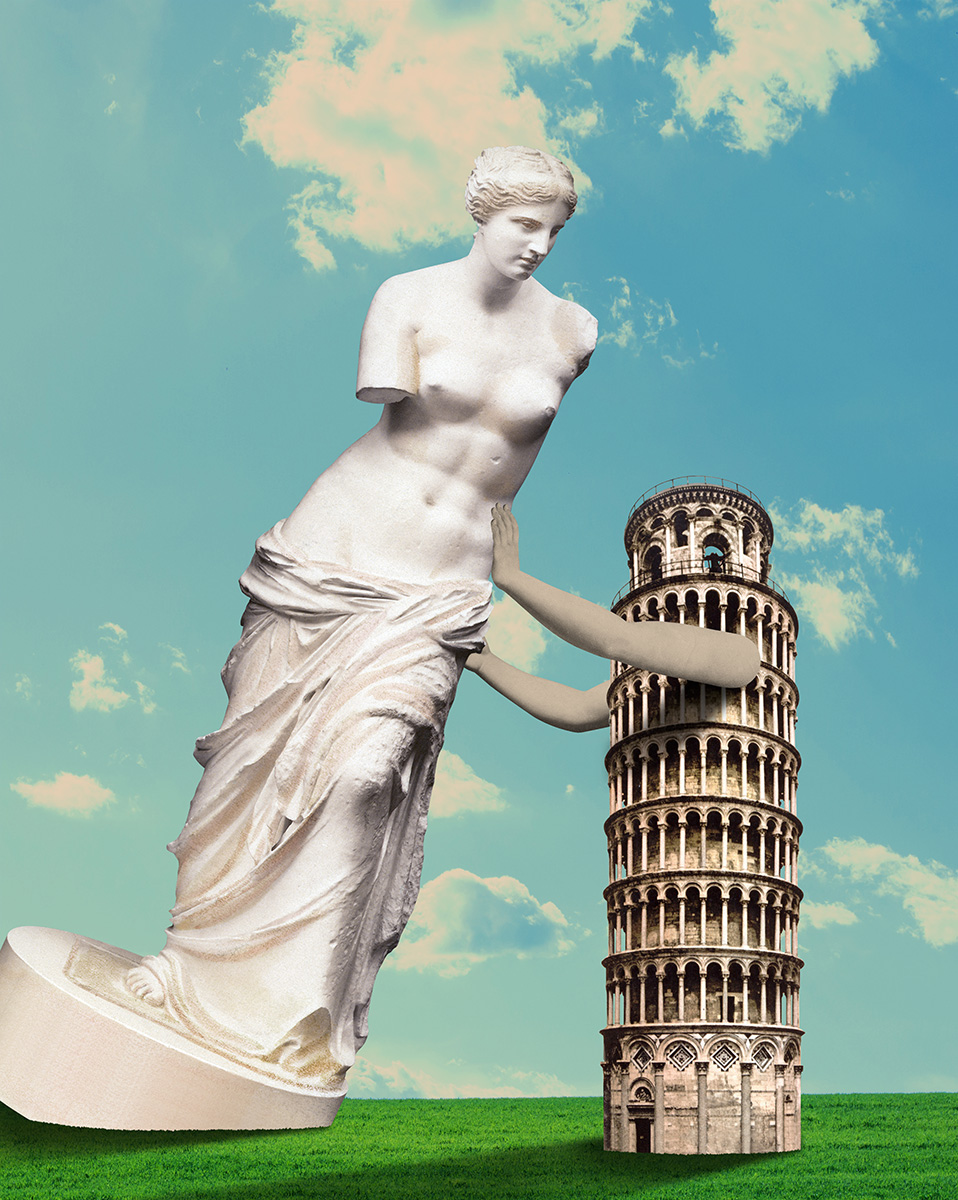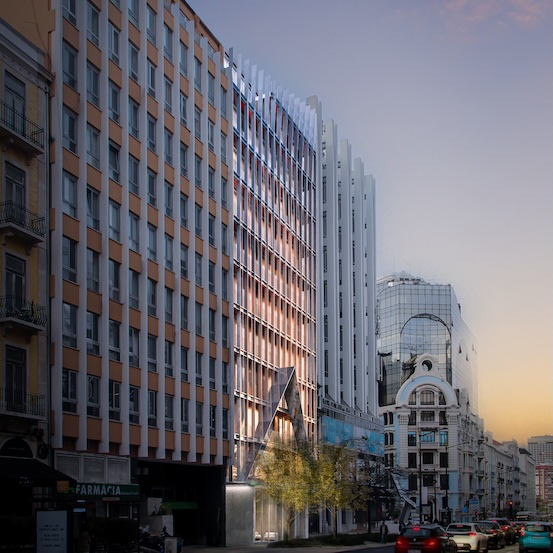Fernando Pessoa, the unchallengeable genius, once wrote what would later become one of the most emblematic phrases of the entire Portuguese language: “God wants, men dream, the masterpiece is born”. In this verse of Mensagem that seems to resume the entire creative existence in eight mere words, there is a small parcel, a detail left unseen. Because sometimes, men make mistakes, and it’s precisely then, that art is (re)born.
Fernando Pessoa, the unchallengeable genius, once wrote what would later become one of the most emblematic phrases of the entire Portuguese language: “God wants, men dream, the masterpiece is born”. In this verse of Mensagem that seems to resume the entire creative existence in eight mere words, there is a small parcel, a detail left unseen. Because sometimes, men make mistakes, and it’s precisely then, that art is (re)born.

To talk about art is to talk about people. The inspiration that operates through the talent of each artist and that is applied to painting, sculpture, design or architecture, is at the origin of some of the most beautiful masterpieces that decorate the museums of the world and the walls of our imagination. When confronted with the beauty of all these art forms, absorbed and overwhelmed, we forget hands like ours were what, in fact, created them. And, as human beings, nothing defines us better than error. We’ve grown accustomed to associating this concept to disaster, to the very foundation of ruin. But in art, beauty and error coexist, they walk hand in hand and create a symbiosis where the first wouldn’t exist without the second. Perhaps the real beauty of error lies where we don’t recognize it, for the perfection of imperfection is all encompassing. Looking at the final product, everything seems so right that error becomes inconceivable. Maybe it is our very own definition of error that is, in fact, wrong.
And speaking of mistakes, or better yet, beautiful mistakes, it’s necessary to also take into account the ones that only exist because we choose to fight against our nature, against the elements, against our own foundations. The Tower of Pisa is the perfect example. Built more than 800 years ago, the bell tower we can easily find on every postcard or bookshelf under the title “The most important Italian monuments” is, at the very least, a phenomenon. Its peculiar and rather risqué character, way beyond its height of 56 meters or its nearly 300 climbing steps, is what captured the world’s interest and what until this day demands an unnegotiable spot on our bucket lists. We’re of course referring to its rather indiscrete inclination. The 3,99 degrees of leaning are what make the image of the Tower of Pisa something very hard to forget. Even considering the pre-Instagram era, our memory instantly remotes to the many arms that have held it, the kisses, the ice-cream cones on its base, the acrobatic maneuvers, the badly placed alignments and unplanned high-fives this little piece of architecture history has witnessed. The error gave place to curiosity, although chance was the one dictating it. Contrary to what was the common belief during the IX century, at the beginning of construction there was no plan whatsoever for it to acquire this about-to-fall-down look. In fact, it was idealized as any other tower: straight. The soil upon which it was edified though, was sandy, poorly consolidated and unstable, condemning the Tower to its very characteristic leaning from the start. When reaching alarming tilting values that would put at risk the masterpiece of an until this day unknown author, a complex soil leveling project was put in motion during the 90s in order to revert the potentially catastrophic effects the 5,5 degree inclination registered at the beginning of that decade could induce on the structure. But the power of error was stronger. The Tower of Pisa rejected the very soil it stands upon, its foundation, its predestinated support and, refusing to crumble all at once, it gradually leans towards the ground. Slowly, reclined on its own perpetuity, it’s as if it is resting after a rebellious euphoria, after an imperative repulse of what it must or should do. And like that it stands, watching time go by… just like us.
Venus or Aphrodite, the denominations vary depending on who you pose the question to, if to Romans or Greeks – time is funny like that. Being that it is one of the best examples of Greek sculpture there is record of, Venus was the chosen name for the most well-known artistic representation of the goddess of love and beauty, the statue we now know as Venus of Milo. The uncountable number of books filled with images and depictions of this piece, which was found on the Island of Melos in 1820, attest to the fact that it has since then been considered an icon of its contemporary art history period, the Hellenistic. It would be too reckless to disregard the various mysteries surrounding Venus of Milo, even more so if we consider how much they have contributed to the fascination the sculpture has always prompted near the crowds, also getting the attention of King Luis XVIII of France and Napoleon Bonaparte along the way. As in every good story, it’s the little details that dictate the path of each character, whether they’re made of flesh and bone or of skill and virtuoso. From the first moment the statue was discovered in the XIX century, allegedly by a farmer while he was digging wreckage from other ruins, there has been speculation around it. One could argue its transcending gracefulness and elegance were more than enough reasons for it, but the enigma was centered around a more specific aspect (or two): her arms. Where are the arms of Venus of Milo? What was the original position of the surviving nymph of the II century BC? Was her left arm really holding an apple? As questions pile up, the myth persists. Many years later, after all theories blurred into the threads of time, the Louvre Museum in Paris, where the statue is permanently in exhibition, stated that the original arms – the ones that could help reveal the pose and allow for a deepened interpretation of the mythological episode this unusual Venus was born into – have never been found. It was precisely with this outcome that could have easily kickstarted one of the biggest disenchantments of the entire artistic sphere, that Venus of Milo consolidated its masterpiece status: its incomplete finish, due not to artistic error, but to the natural decadence not even the finest creations manage to escape from, has granted the sculpture a beauty that is more real, more imperfect, and, we’ll risk to say, more human.
As mentioned previously, to talk about art is to talk about people. Whether considering the artistic subject or those who imagine it, art cannot be separated from the human experience, including its most obscure moments, its biggest obsessions and points of no return. And if the world has ever witnessed a turning point in the history of art, that point was Mona Lisa. Never as a 77 x 33 cm painting received as many love letters, been as visited, been the object of such extensive analyses, or possessed an insurance rating as high as the Gioconda by Leonardo Da Vinci, that to this day holds the Guinness World Record in that category, with an insurance valuation of 100 million dollars in 1962 (considering the inflation, we’re talking around 660 million dollars in 2019). The portrait that is regarded as the archetype of perfection of the Italian Renaissance, the painting believed to be of a nobleman’s wife, Lisa Gherardini, brings thousands of people every year to the cultural and artistic epicenter of the world, the Louvre Museum in Paris, where Da Vinci’s masterpiece was actually once stollen from, in 1911. The resemblance of Mona Lisa’s facial traits to the ones usually associated with Virgen Mary confer a solemn, almost spiritual gist to the piece, but there are elements of her expression that cause more than admiration – they raise questions. Her eyebrows, or lack thereof, for example. Indeed, we are not in the presence of the artistic error of the century, Da Vinci would have painted eyebrows on the face of his Gioconda, but according to information collected by the Parisian engineer Pascal Cotte, these have been obliterated, fallen victims of years of restoration efforts. Despite evidence to the contrary, some historians still insist to this day that Leonardo Da Vinci might not have had the time to finish his most iconic work of art. In this case, the only thing we know for sure is that without eyebrows, Mona Lisa’s face is emptier. Her expression becomes more enigmatic, reinforced by this missing (but not mistaken) element, that has only contributed to the eternal discussion, as associated to the painting as its tones of yellow gold: is the Gioconda crying or smiling?
When it comes to color (and especially when it comes to yellow), Vincent van Gogh, the famous Dutch painter that has brought to life some of the most well-known artwork of the XIX century, is a mandatory reference. In his approximately ten years of activity, he produced circa 860 oil paintings within his more than two thousand artworks, while also tragically fulfilling all the prophecies that constitute the fate of a suffering romantic genius. Sunflowers, for example, is a collective of two series of oil paintings, Paris and Arles, named after the cities they were painted on. The second and most famous of the two, conceived between 1888 and 1889, is the one we more easily associate today with this piece that is one of Van Gogh’s personal favorites, talentedly created using only three shades of yellow. This specific color, and all its variations, that fascinated the painter so much, were at the genesis of the chromatic evolution lately observed in this artwork. The thing is, the sunflowers’ yellow is changing. Van Gogh imagined a pale shade for his favorite flowers, clearer and more limpid, but nature and the passage of time are working against that vision. The University of Antwerp published a study in which the process of oxidation of the paint due to sunlight incidence in these artworks is explained. “Nature is darkening it”, as Koen Janssens, PhD and leader of the investigation explains. The brownish tone that comes from the chemical reaction between sunlight and the pigments could be interpreted as a natural corruption of the artist’s will, although, simultaneously, it produced a much happier ending than that. The sunflowers are less pale and saturated yes, however, through that erratic oxidation, they conquered a much more realistic appearance, as if time itself touched and colored each and every one of them.
As everything in life, endings are always some sort of beginning, therefore it is our duty to end this article on the history of art with one of its biggest and most important chapters, the incomparable Michelangelo. Born on the 6th of March 1475 in Tuscany, Italy, the sculpturer, painter, architect and poet is considered one of the biggest propulsors of the artistic period we identify as High Renaissance, and one of the most globally recognized artists the world has ever seen. A perfectionist to the tinniest of details, the lifework of Michelangelo echoes to our day and age through his profound knowledge of human physiognomy together with an extreme artistic sensibility, the same qualities that assured him the respect of crowds, kings, popes and innumerous figures of authorities in his time. Given all this, we couldn’t talk about art, as we know it today, without Michelangelo. We’d never have the image of The Creation of Adam as clearly in our minds without Michelangelo, and, most likely, we wouldn’t have the same beauty ideals that have imprinted centuries of painting and sculpture without Michelangelo, because without him, we wouldn’t have David. The statue that dictated what generations of artists and admirers held as the human artwork that better resembles divine beauty, David is ultimate proof that the beauty of error is as absolute as it is decisive. The marble block on which the artist’s hands worked from 1501 and 1504 had, allegedly, a structural defect. According to the story, three other very highly regarded artists had tried to work on the colossal block for their own sculptures, but after having no success, they rejected it, condemning it to its own oblivion. Michelangelo chose it on purpose, precisely because of its story of disowning, as a personal challenge, to turn it into the white canvas of one of the most consecrated works of art the world as ever seen – and that ended up becoming one of the most preponderant sculptures in history. For years that flawed piece of marble waited for someone to see beyond the error, and David happened. The rest, as they say, is history.
Originally published on Vogue Portugal November issue, "The Beauty of Imperfection."
Most popular


Relacionados






